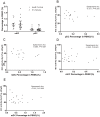Anti-retroviral therapy decreases but does not normalize indoleamine 2,3-dioxygenase activity in HIV-infected patients
- PMID: 24983463
- PMCID: PMC4077698
- DOI: 10.1371/journal.pone.0100446
Anti-retroviral therapy decreases but does not normalize indoleamine 2,3-dioxygenase activity in HIV-infected patients
Abstract
Background: Indoleamine 2,3-dioxygenase (IDO), which is mainly expressed in activated dendritic cells, catabolizes tryptophan to kynurenine and other downstream catabolites. It is known to be an immune mediator in HIV pathogenesis. The impact of anti-retroviral therapy on its activity has not been well established.
Methods: We measured systemic IDO activity (the ratio of plasma kynurenine to tryptophan) in HIV-infected patients before and after highly active antiretroviral therapy (HAART) and its association with a microbial translocation marker, soluble CD14 (sCD14).
Results: Among 76 participants, higher baseline IDO activity was associated with lower CD4+ T cell counts (P<0.05) and higher plasma sCD14 levels (P<0.001). After 1 year of HAART, IDO activity decreased significantly (P<0.01), but was still higher than in healthy controls (P<0.05). The baseline IDO activity did not predict CD4+ T cell recovery after 1 year of therapy. The percentages of myeloid and plasmacytoid dendritic cells were not correlated with IDO activity.
Conclusions: IDO activity is elevated in HIV-infected patients, which is partially associated with microbial translocation. HAART reduced, but did not normalize the activity of IDO.
Conflict of interest statement
Figures




Similar articles
-
Indoleamine 2, 3-Dioxygenase-Mediated Tryptophan Catabolism: A Leading Star or Supporting Act in the Tuberculosis and HIV Pas-de-Deux?Front Cell Infect Microbiol. 2019 Oct 29;9:372. doi: 10.3389/fcimb.2019.00372. eCollection 2019. Front Cell Infect Microbiol. 2019. PMID: 31737575 Free PMC article. Review.
-
Plasma Indoleamine 2,3-Dioxygenase Activity Is Associated With the Size of the Human Immunodeficiency Virus Reservoir in Patients Receiving Antiretroviral Therapy.Clin Infect Dis. 2019 Apr 8;68(8):1274-1281. doi: 10.1093/cid/ciy676. Clin Infect Dis. 2019. PMID: 30107503 Free PMC article.
-
Host genetic predictors of the kynurenine pathway of tryptophan catabolism among treated HIV-infected Ugandans.AIDS. 2016 Jul 17;30(11):1807-15. doi: 10.1097/QAD.0000000000001124. AIDS. 2016. PMID: 27088321 Free PMC article.
-
The kynurenine pathway of tryptophan catabolism, CD4+ T-cell recovery, and mortality among HIV-infected Ugandans initiating antiretroviral therapy.J Infect Dis. 2014 Aug 1;210(3):383-91. doi: 10.1093/infdis/jiu115. Epub 2014 Feb 28. J Infect Dis. 2014. PMID: 24585899 Free PMC article.
-
Indoleamine 2,3-dioxygenase-2; a new enzyme in the kynurenine pathway.Int J Biochem Cell Biol. 2009 Mar;41(3):467-71. doi: 10.1016/j.biocel.2008.01.005. Epub 2008 Jan 11. Int J Biochem Cell Biol. 2009. PMID: 18282734 Review.
Cited by
-
The impact of silver nanoclay functionalisation on optical and electrochemical properties.RSC Adv. 2023 Jan 11;13(3):2123-2130. doi: 10.1039/d2ra06549e. eCollection 2023 Jan 6. RSC Adv. 2023. PMID: 36712604 Free PMC article.
-
The IDOze Study: The Link Between Sleep Disruption and Tryptophan-Kynurenine Pathway Activation in Women With Human Immunodeficiency Virus.J Infect Dis. 2022 Oct 17;226(8):1451-1460. doi: 10.1093/infdis/jiac287. J Infect Dis. 2022. PMID: 35801535 Free PMC article.
-
HBV and HIV viral load but not microbial translocation or immune activation are associated with liver fibrosis among patients in South Africa.BMC Infect Dis. 2018 May 8;18(1):214. doi: 10.1186/s12879-018-3115-8. BMC Infect Dis. 2018. PMID: 29739341 Free PMC article.
-
Gut barrier structure, mucosal immunity and intestinal microbiota in the pathogenesis and treatment of HIV infection.AIDS Res Ther. 2016 Apr 11;13:19. doi: 10.1186/s12981-016-0103-1. eCollection 2016. AIDS Res Ther. 2016. PMID: 27073405 Free PMC article. Review.
-
Indoleamine 2, 3-Dioxygenase-Mediated Tryptophan Catabolism: A Leading Star or Supporting Act in the Tuberculosis and HIV Pas-de-Deux?Front Cell Infect Microbiol. 2019 Oct 29;9:372. doi: 10.3389/fcimb.2019.00372. eCollection 2019. Front Cell Infect Microbiol. 2019. PMID: 31737575 Free PMC article. Review.
References
-
- Mellor A (2005) Indoleamine 2,3 dioxygenase and regulation of T cell immunity. Biochem Biophys Res Commun 338: 20–24. - PubMed
-
- Hassanain HH, Chon SY, Gupta SL (1993) Differential regulation of human indoleamine 2,3-dioxygenase gene expression by interferons-gamma and -alpha. Analysis of the regulatory region of the gene and identification of an interferon-gamma-inducible DNA-binding factor. J Biol Chem 268: 5077–5084. - PubMed
-
- Mellor AL, Munn DH (2004) IDO expression by dendritic cells: tolerance and tryptophan catabolism. Nat Rev Immunol 4: 762–774. - PubMed
Publication types
MeSH terms
Substances
LinkOut - more resources
Full Text Sources
Other Literature Sources
Medical
Research Materials

